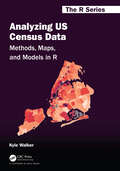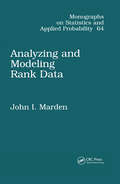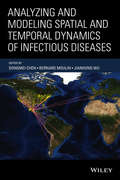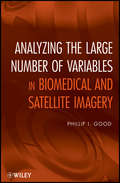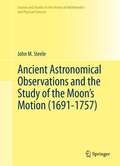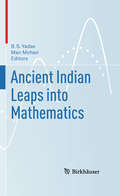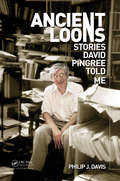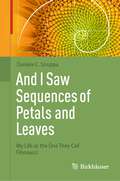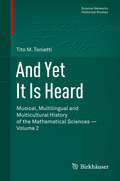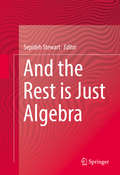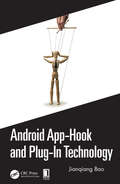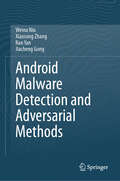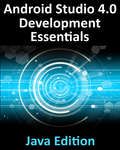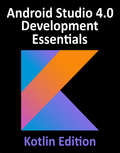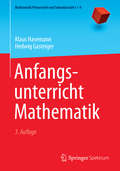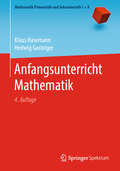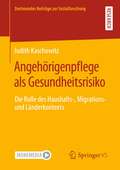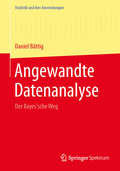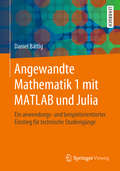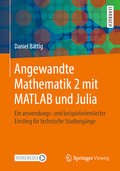- Table View
- List View
Analyzing US Census Data: Methods, Maps, and Models in R (Chapman & Hall/CRC The R Series)
by Kyle WalkerCensus data are widely used by practitioners to understand demographic change, allocate resources, address inequalities, and make sound business decisions. Until recently, projects using US Census data have required proficiency with multiple web interfaces and software platforms to prepare, map, and present data products. This book introduces readers to tools in the R programming language for accessing and analyzing Census data, helping analysts manage these types of projects in a single computing environment. Chapters in this book cover the following key topics: • Rapidly acquiring data from the decennial US Census and American Community Survey using R, then analyzing these datasets using tidyverse tools; • Visualizing US Census data with a wide range of methods including charts in ggplot2 as well as both static and interactive maps; • Using R as a geographic information system (GIS) to manage, analyze, and model spatial demographic data from the US Census; • Working with and modeling individual-level microdata from the American Community Survey’s PUMS datasets; • Applying these tools and workflows to the analysis of historical Census data, other US government datasets, and international Census data from countries like Canada, Brazil, Kenya, and Mexico. Kyle Walker is an associate professor of geography at Texas Christian University, director of TCU’s Center for Urban Studies, and a spatial data science consultant. His research focuses on demographic trends in the United States, demographic data visualization, and software tools for open spatial data science. He is the lead author of a number of R packages including tigris, tidycensus, and mapboxapi.
Analyzing and Modeling Rank Data (Chapman & Hall/CRC Monographs on Statistics and Applied Probability)
by John I MardenThis book is the first single source volume to fully address this prevalent practice in both its analytical and modeling aspects. The information discussed presents the use of data consisting of rankings in such diverse fields as psychology, animal science, educational testing, sociology, economics, and biology. This book systematically presents th
Analyzing and Modeling Spatial and Temporal Dynamics of Infectious Diseases
by Jianhong Wu Bernard Moulin Dongmei ChenFeatures modern research and methodology on the spread of infectious diseases and showcases a broad range of multi-disciplinary and state-of-the-art techniques on geo-simulation, geo-visualization, remote sensing, metapopulation modeling, cloud computing, and pattern analysisGiven the ongoing risk of infectious diseases worldwide, it is crucial to develop appropriate analysis methods, models, and tools to assess and predict the spread of disease and evaluate the risk. Analyzing and Modeling Spatial and Temporal Dynamics of Infectious Diseases features mathematical and spatial modeling approaches that integrate applications from various fields such as geo-computation and simulation, spatial analytics, mathematics, statistics, epidemiology, and health policy. In addition, the book captures the latest advances in the use of geographic information system (GIS), global positioning system (GPS), and other location-based technologies in the spatial and temporal study of infectious diseases.Highlighting the current practices and methodology via various infectious disease studies, Analyzing and Modeling Spatial and Temporal Dynamics of Infectious Diseases features:Approaches to better use infectious disease data collected from various sources for analysis and modeling purposesExamples of disease spreading dynamics, including West Nile virus, bird flu, Lyme disease, pandemic influenza (H1N1), and schistosomiasisModern techniques such as Smartphone use in spatio-temporal usage data, cloud computing-enabled cluster detection, and communicable disease geo-simulation based on human mobilityAn overview of different mathematical, statistical, spatial modeling, and geo-simulation techniquesAnalyzing and Modeling Spatial and Temporal Dynamics of Infectious Diseases is an excellent resource for researchers and scientists who use, manage, or analyze infectious disease data, need to learn various traditional and advanced analytical methods and modeling techniques, and become aware of different issues and challenges related to infectious disease modeling and simulation. The book is also a useful textbook and/or supplement for upper-undergraduate and graduate-level courses in bioinformatics, biostatistics, public health and policy, and epidemiology.
Analyzing the Large Number of Variables in Biomedical and Satellite Imagery
by Phillip I. GoodThis book grew out of an online interactive offered through statcourse.com, and it soon became apparent to the author that the course was too limited in terms of time and length in light of the broad backgrounds of the enrolled students. The statisticians who took the course needed to be brought up to speed both on the biological context as well as on the specialized statistical methods needed to handle large arrays. Biologists and physicians, even though fully knowledgeable concerning the procedures used to generate microaarrays, EEGs, or MRIs, needed a full introduction to the resampling methods--the bootstrap, decision trees, and permutation tests, before the specialized methods applicable to large arrays could be introduced. As the intended audience for this book consists both of statisticians and of medical and biological research workers as well as all those research workers who make use of satellite imagery including agronomists and meteorologists, the book provides a step-by-step approach to not only the specialized methods needed to analyze the data from microarrays and images, but also to the resampling methods, step-down multi-comparison procedures, multivariate analysis, as well as data collection and pre-processing. While many alternate techniques for analysis have been introduced in the past decade, the author has selected only those techniques for which software is available along with a list of the available links from which the software may be purchased or downloaded without charge. Topical coverage includes: very large arrays; permutation tests; applying permutation tests; gathering and preparing data for analysis; multiple tests; bootstrap; applying the bootstrap; classification methods; decision trees; and applying decision trees.
Anandadayak Ganit class 1 - NCERT - 23: आनन्ददायकं गणितम् कक्षा १ - एनसीईआरटी - २३
by National Council of Educational Research and Trainingइयत्ता पहिलीसाठी आनंददायी गणित या पाठ्यपुस्तकातील आशय NCF-FS 2022 मध्ये नमूद केलेल्या पुढील चार घटकांवर आधारित आहे तोंडी गणित चर्चा, कौशल्य शिकवणे, कौशल्य सराव आणि गणिती खेळ सर्व अध्यायांमध्ये समाविष्ट केले गेले आहेत. त्यापैकी बहुतेक एकात्मिक पद्धतीने सादर केले आहेत. तथापि, खालील प्रकरणे केवळ गणितीय समज आणि क्षमता विकसित करण्याच्या अभ्यासक्रमाच्या उद्दिष्टाशी (CG-8) आणि परिमाणे, आकार आणि मापे यांद्वारा जग ओळखू शकण्याशीच संरेखित नाहीत तर NCF-FS 2022 मध्ये दिलेल्या सर्वांगीण विकासाकडे नेणाऱ्या इतर सर्व अभ्यासक्रम व अभ्यासक्रमिय उद्दिष्टांशीदेखील सरेखित आहेत - मौखिक गणित चर्चा, कौशल्यशिक्षण, कौशल्यसराव आणि गणिती खेळ. बौद्धिक आव्हान आणि विचारप्रवर्तक कार्यांमुळे गणिताचे अध्ययन व निर्णयनक्षमता अधिक चांगल्या प्रकारे होते. मेंदूला सतावणारे प्रश्न, कोडी, कूट प्रश्न यामुळे नेहमीच्या शिकण्याच्या जोडीने मुलांना याची संधी मिळते. मुलांच्या वयाला साजेशी अनेक कोडी या पुस्तकात दिली आहेत.
Anandadayak Ganit class 2 - NCERT - 23: आनन्ददायकं गणितम् कक्षा २री - एनसीईआरटी - २३
by National Council of Educational Research and Trainingइयत्ता दुसरीसाठी असलेले आनंददायी गणित असे नाव असलेले गणिताचे पाठ्यपुस्तक NEP 2020, NCF-FS 2022 तसेच पायाभरणीच्या टप्प्यासाठीचा अभ्यासक्रम यांच्या शिफारसी डोळ्यासमोर ठेवून तयार केले आहे। बालवाटिका 1 ते 3 तसेच पहिली झाल्यावर (3-8 वर्षे वयात) दुसरीत जाणाऱ्या मुलाला अंकांचे ज्ञान झालेले असते, असे यात गृहीत धरले आहे। परंतु, आपल्या देशातील विविधता बघता, कदाचित काही मुलांची एकदम शाळेत पहिलीत गेल्यावरच पहिल्यांदा अंकांची ओळख होत असेल, असेही होऊ शकते। हे क्रमिक पुस्तक तयार करताना अशा परिस्थितीचाही विचार केलेला आहे। वयाच्या या टप्प्यावरील मुले मुक्तपणे खेळणे, खेळणी यात रमतात। हे लक्षात घेऊन, अवकाशीय समज, अंकहाताळणी, गणितीय आणि संगणकीय संकल्पना इ। शिकवण्यासाठीच्या उपक्रमांमध्ये खेळ, खेळणी यांचा वापर करण्यासाठी पुष्कळ वाव ठेवलेला आहे। यामुळे प्रत्येक नवीन संकल्पना किंवा कौशल्य शिकताना मूर्त वस्तूंकडून चित्रस्वरूपाकडे व त्याकडून अमूर्त कल्पनांपर्यंतचे संक्रमण सहजपणे होऊ शकते। सर्वांगीण विकासासाठी अनुभवातून शिक्षण हे उद्दिष्ट डोळ्यासमोर ठेवून, इयत्ता दुसरीसाठी असलेल्या आनंददायी गणित या पुस्तकामध्ये, वर्गात आणि वर्गाबाहेर करण्यासारखे अनेक उपक्रम दिले आहेत। यातील सर्व प्रकरणांमध्ये, उपक्रमाधारित कार्यांच्या माध्यमातून गणितीय संकल्पनांचे आकलन करून दिले आहे। सक्तीने, नाखुषीने गणित शिकण्याऐवजी, आपण खेळ खेळत आहोत अशा भावनेने मुलांनी हे उपक्रम करावेत आणि त्याद्वारे गणितीय संकल्पना आपोआप रुजाव्यात, अशा प्रकारचे वातावरण निर्माण करण्याचा प्रयत्न या पुस्तकातून केलेला आहे।
Anandadayi Ganit class 1 - NCERT - 23: आनंददायी गणित इयत्ता पहिली - एनसीईआरटी - २३
by National Council of Educational Research and Trainingइयत्ता पहिलीसाठी आनंददायी गणित या पाठ्यपुस्तकातील आशय NCF-FS 2022 मध्ये नमूद केलेल्या पुढील चार घटकांवर आधारित आहे तोंडी गणित चर्चा, कौशल्य शिकवणे, कौशल्य सराव आणि गणिती खेळ सर्व अध्यायांमध्ये समाविष्ट केले गेले आहेत. त्यापैकी बहुतेक एकात्मिक पद्धतीने सादर केले आहेत. तथापि, खालील प्रकरणे केवळ गणितीय समज आणि क्षमता विकसित करण्याच्या अभ्यासक्रमाच्या उद्दिष्टाशी (CG-8) आणि परिमाणे, आकार आणि मापे यांद्वारा जग ओळखू शकण्याशीच संरेखित नाहीत तर NCF-FS 2022 मध्ये दिलेल्या सर्वांगीण विकासाकडे नेणाऱ्या इतर सर्व अभ्यासक्रम व अभ्यासक्रमिय उद्दिष्टांशीदेखील सरेखित आहेत - मौखिक गणित चर्चा, कौशल्यशिक्षण, कौशल्यसराव आणि गणिती खेळ. बौद्धिक आव्हान आणि विचारप्रवर्तक कार्यांमुळे गणिताचे अध्ययन व निर्णयनक्षमता अधिक चांगल्या प्रकारे होते. मेंदूला सतावणारे प्रश्न, कोडी, कूट प्रश्न यामुळे नेहमीच्या शिकण्याच्या जोडीने मुलांना याची संधी मिळते. मुलांच्या वयाला साजेशी अनेक कोडी या पुस्तकात दिली आहेत.
Anandadayi Ganit class 2 - NCERT - 23: आनंददायी गणित इयत्ता दुसरी - एनसीईआरटी - २३
by National Council of Educational Research and Trainingइयत्ता दुसरीसाठी असलेले आनंददायी गणित असे नाव असलेले गणिताचे पाठ्यपुस्तक NEP 2020, NCF-FS 2022 तसेच पायाभरणीच्या टप्प्यासाठीचा अभ्यासक्रम यांच्या शिफारसी डोळ्यासमोर ठेवून तयार केले आहे। बालवाटिका 1 ते 3 तसेच पहिली झाल्यावर (3-8 वर्षे वयात) दुसरीत जाणाऱ्या मुलाला अंकांचे ज्ञान झालेले असते, असे यात गृहीत धरले आहे। परंतु, आपल्या देशातील विविधता बघता, कदाचित काही मुलांची एकदम शाळेत पहिलीत गेल्यावरच पहिल्यांदा अंकांची ओळख होत असेल, असेही होऊ शकते। हे क्रमिक पुस्तक तयार करताना अशा परिस्थितीचाही विचार केलेला आहे। वयाच्या या टप्प्यावरील मुले मुक्तपणे खेळणे, खेळणी यात रमतात। हे लक्षात घेऊन, अवकाशीय समज, अंकहाताळणी, गणितीय आणि संगणकीय संकल्पना इ। शिकवण्यासाठीच्या उपक्रमांमध्ये खेळ, खेळणी यांचा वापर करण्यासाठी पुष्कळ वाव ठेवलेला आहे। यामुळे प्रत्येक नवीन संकल्पना किंवा कौशल्य शिकताना मूर्त वस्तूंकडून चित्रस्वरूपाकडे व त्याकडून अमूर्त कल्पनांपर्यंतचे संक्रमण सहजपणे होऊ शकते। सर्वांगीण विकासासाठी अनुभवातून शिक्षण हे उद्दिष्ट डोळ्यासमोर ठेवून, इयत्ता दुसरीसाठी असलेल्या आनंददायी गणित या पुस्तकामध्ये, वर्गात आणि वर्गाबाहेर करण्यासारखे अनेक उपक्रम दिले आहेत। यातील सर्व प्रकरणांमध्ये, उपक्रमाधारित कार्यांच्या माध्यमातून गणितीय संकल्पनांचे आकलन करून दिले आहे। सक्तीने, नाखुषीने गणित शिकण्याऐवजी, आपण खेळ खेळत आहोत अशा भावनेने मुलांनी हे उपक्रम करावेत आणि त्याद्वारे गणितीय संकल्पना आपोआप रुजाव्यात, अशा प्रकारचे वातावरण निर्माण करण्याचा प्रयत्न या पुस्तकातून केलेला आहे।
Anandmay Ganit class 1 - NCERT - 23: आनंदमय गणित १ली कक्षा - एनसीईआरटी - २३
by Rashtriy Shaikshik Anusandhan Aur Prashikshan Parishadआनंदमय गणित कक्षा 1 पाठ्यपुस्तक का निर्माण करते हुए मुख्य रूप से राष्ट्रीय शिक्षा नीति 2020 ने प्रारंभिक विकासात्मक चरण (3 से 8 वर्ष) के दौरान सीखने की एक मज़बूत नींव विकसित करने के महत्व को मान्यता दी है। इसमें बुनियादी साक्षरता और संख्यात्मकता पर ज़ोर देने के साथ-साथ बच्चों का संज्ञानात्मक विकास शामिल है। पाठ्यचर्या के लक्ष्यों, दक्षताओं और सीखने के परिणामों को बुनियादी स्तर की राष्ट्रीय पाठ्यचर्या की रूपरेखा 2022 में स्पष्ट रूप से परिभाषित किया गया है। बच्चों के समग्र विकास के नीतिगत परिप्रेक्ष्य को ध्यान में रखते हुए बुनियादी स्तर के लिए राष्ट्रीय पाठ्यचर्या की रूपरेखा (आधारभूत स्तर) शारीरिक, सामाजिक, भावनात्मक, नैतिक, संज्ञानात्मक, भाषा, साक्षरता, सौंदर्य और सांस्कृतिक और सकारात्मक सीखने की आदतें, जैसे-विकासात्मक डोमेन से जुड़े पाठ्यचर्या लक्ष्यों, दक्षताओं और सीखने के परिणामों की अनुशंसा करती है। इसके अनुवर्ती के रूप में राष्ट्रीय शैक्षिक अनुसंधान और प्रशिक्षण परिषद् द्वारा विकसित आधारभूत स्तर के पाठ्यक्रम में संज्ञानात्मक डोमेन के तहत गणित और संख्यात्मकता सम्मिलित है। पाठ्यपुस्तकों सहित गणित के लिए अधिगम शिक्षण सामग्री विकसित करते समय अन्य सभी डोमेन के एकीकरण पर भी बल दिया गया है।
Ancient Astronomical Observations and the Study of the Moon’s Motion (Sources and Studies in the History of Mathematics and Physical Sciences)
by John M. SteeleThe discovery of a gradual acceleration in the moon's mean motion by Edmond Halley in the last decade of the seventeenth century led to a revival of interest in reports of astronomical observations from antiquity. These observations provided the only means to study the moon's 'secular acceleration', as this newly-discovered acceleration became known. This book contains the first detailed study of the use of ancient and medieval astronomical observations in order to investigate the moon's secular acceleration from its discovery by Halley to the establishment of the magnitude of the acceleration by Richard Dunthorne, Tobias Mayer and Jérôme Lalande in the 1740s and 1750s. Making extensive use of previously unstudied manuscripts, this work shows how different astronomers used the same small body of preserved ancient observations in different ways in their work on the secular acceleration. In addition, this work looks at the wider context of the study of the moon's secular acceleration, including its use in debates of biblical chronology, whether the heavens were made up of æther, and the use of astronomy in determining geographical longitude. It also discusses wider issues of the perceptions and knowledge of ancient and medieval astronomy in the early-modern period. This book will be of interest to historians of astronomy, astronomers and historians of the ancient world.
Ancient Indian Leaps into Mathematics
by B. S. Yadav Man MohanThis book presents contributions of mathematicians covering topics from ancient India, placing them in the broader context of the history of mathematics. Although the translations of some Sanskrit mathematical texts are available in the literature, Indian contributions are rarely presented in major Western historical works. Yet some of the well-known and universally-accepted discoveries from India, including the concept of zero and the decimal representation of numbers, have made lasting contributions to the foundation of modern mathematics. Through a systematic approach, this book examines these ancient mathematical ideas that were spread throughout India, China, the Islamic world, and Western Europe.
Ancient Loons: Stories Pingree Told Me
by Philip J. Davis"Ah, I'm Pingree. We meet again. Splendid. Won't you sit down?"I looked around David's room. Short of the library stacks, I had never seen so many books piled into a single room. Where could I sit down? Every square inch of horizontal surface was covered. Books, papers, notes, manuscripts-all congregated in random and chaotic disorder.This small en
And I Saw Sequences of Petals and Leaves: My Life as the One They Call Fibonacci
by Daniele C. StruppaIn this captivating historical novel, Daniele Struppa skillfully weaves a fictional autobiography, bringing Fibonacci to life with vivid details of his upbringing and adult years in Medieval Europe. As we explore the historical context of Fibonacci's time, we delve into the intriguing aspects of a bygone era, painting a compelling picture of a man whose contributions to mathematics continue to resonate today. From his groundbreaking work on congruent numbers to the famous numerical sequence that bears his name, the author invites readers to imagine the creative sparks that ignited Fibonacci's mathematical innovations. When historical evidence is elusive, accuracy and passion are seamlessly combined, offering plausible scenarios grounded in documented facts. A meticulously crafted apparatus of notes distinguishes fact from fiction, providing readers with a clear guide to navigate this enthralling reconstruction of Fibonacci's life. Step into the medieval world ofLeonardo Fibonacci, one of the most celebrated mathematicians in history, and discover the man behind the mathematical genius. Mathematicians and curious readers alike will appreciate the allure of Fibonacci's mathematical brilliance.
And Yet It Is Heard: Musical, Multilingual and Multicultural History of the Mathematical Sciences - Volume 2 (Science Networks. Historical Studies #47)
by Tito M. ToniettiWe bring into full light some excerpts on musical subjects which were until now scattered throughout the most famous scientific texts. The main scientific and musical cultures outside of Europe are also taken into consideration. The first and most important property to underline in the scientific texts examined here is the language they are written in. This means that our multicultural history of the sciences necessarily also becomes a review of the various dominant languages used in the different historical contexts. In this volume, the history of the development of the sciences is told as it happened in real contexts, not in an alienated ideal world.
And the Rest is Just Algebra
by Sepideh StewartThis book addresses college students' weak foundation in algebra, its causes, and potential solutions to improve their long-term success and understanding in mathematics as a whole. The authors, who are experts in a wide variety of fields, emphasize that these difficulties are more complex than just forgotten rules, and offer strategic approaches from a number of angles that will increase the chances of student understanding. Instructors who are frustrated with their students' lack of skills and knowledge at college level will find this volume helpful, as the authors confront the deeper reasons why students have difficulties with Algebra and reveal how to remedy the issue.
Android App-Hook and Plug-In Technology
by Jianqiang BaoThis book presents the Android plug-in technology used in Android development. This technology is widely used by a majority of Chinese internet companies, and is becoming more widely used worldwide. The book fully describes the history of Android plug-in technology, the installation and startup process, and new features of the Android plug-in technology. It also explores plug-in solutions for peripheral technologies. The book is designed to help Android app developers better understand the underlying technology of the Android system. Features Introduces Android system knowledge, including the communication between AMS and four components Describes the Hook technique by Proxy.newProxyInstance and reflection, to modify Android system behavior, for example, to launch an activity not declared in the AndroidManifest. Shows how to use the Hook apk packaging process in Gradle Covers how to merge the resources in the plugin app and the host app, and how to merge dex of the host app and all the plugin apps Presents the SO technique and how to launch SO files dynamically
Android Malware Detection and Adversarial Methods
by Xiaosong Zhang Weina Niu Ran Yan Jiacheng GongThe rise of Android malware poses a significant threat to users’ information security and privacy. Malicious software can inflict severe harm on users by employing various tactics, including deception, personal information theft, and device control. To address this issue, both academia and industry are continually engaged in research and development efforts focused on detecting and countering Android malware. This book is a comprehensive academic monograph crafted against this backdrop. The publication meticulously explores the background, methods, adversarial approaches, and future trends related to Android malware. It is organized into four parts: the overview of Android malware detection, the general Android malware detection method, the adversarial method for Android malware detection, and the future trends of Android malware detection. Within these sections, the book elucidates associated issues, principles, and highlights notable research. By engaging with this book, readers will gain not only a global perspective on Android malware detection and adversarial methods but also a detailed understanding of the taxonomy and general methods outlined in each part. The publication illustrates both the overarching model and representative academic work, facilitating a profound comprehension of Android malware detection.
Android Studio 4.0 Development Essentials - Java Edition: Build Android apps with Android Studio 4.0 and Java
by Neil SmythExplore Android Studio 4.0 and update your skills to build modern applications in Java Key Features Set up your Android development and testing environments Create user interfaces with Android Studio Editor, XML, and Java Explore the essential elements of Android Jetpack Book Description Android rolls out frequent updates to meet the demands of the dynamic mobile market and to enable its developer community to lead advancements in application development. This book focuses on the updated features of Android Studio (the fully integrated development environment launched by Google) to build reliable Android applications using Java. The book starts by outlining the steps necessary to set up an Android development and testing environment. You'll then learn how to create user interfaces with the help of Android Studio Layout Editor, XML files, and by writing the code in Java. The book introduces you to Android architecture components and advanced topics such as intents, touchscreen handling, gesture recognition, multi-window support integration, and biometric authentication, and lets you explore key features of Android Studio 4.0, including the layout editor, direct reply notifications, and dynamic delivery. You'll also cover Android Jetpack in detail and create a sample app project using the ViewModel component. Finally, you'll upload your app to the Google Play Console and handle the build process with Gradle. By the end of this book, you'll have gained the skills necessary to develop applications using Android Studio 4.0 and Java. What you will learn Design impressive UI for Android application using Android Studio Editor and Java Understand how Android Jetpack can help you reduce the amount of code Explore unique ways to handle single-touch and multi-touch events Trigger local and remote notifications on the device Integrate biometric authentication into an Android app Create, test, and upload an Android app bundle on Google Play Store Who this book is for This book is for application developers and Java programmers who want to explore Android Studio 4.0 to create powerful Android applications. A basic understanding of Java and the Android SDK will be helpful.
Android Studio 4.0 Development Essentials - Kotlin Edition: Build Android Apps with Android Studio 4.0 and Kotlin
by Neil SmythUpgrade your Android Studio skills and confidently create, test, and upload Android applications using KotlinKey FeaturesDiscover how to set up Android development and testing environmentsPractice object-oriented programming (OOP) in KotlinExplore all the major elements of Android JetpackBook DescriptionKotlin as an Android-compatible programming language is becoming increasingly popular. Fully updated for Android Studio 4.0, this book will teach you the skills necessary to develop Android-based applications using Kotlin.Starting with the basics, this book outlines the steps necessary to set up Android development and testing environments, and goes on to introduce you to programming in Kotlin. You'll practice Java to Kotlin code conversion and explore data types, operators, expressions, loops, functions, as well as the basics of OOP in Kotlin. You'll then learn about Android architecture components and advanced topics, such as intents, touchscreen handling, gesture recognition, multi-window support integration, and biometric authentication. As you make progress, you'll explore Android Studio 4.0's key features, including layout editor, direct reply notifications, and dynamic delivery. You'll also delve into Android Jetpack and create a sample app project using ViewModel, the Android Jetpack component. Finally, you will upload your app to Google Play Console and model the build process using Gradle.By the end of this Android book, you'll be fully prepared to develop applications using Android Studio 4.0 and Kotlin.What you will learnBuild Android apps by writing less error-prone code using KotlinReduce the amount of code using Android JetpackExplore unique ways of handling single and multi-touch eventsTrigger local and remote notifications on the deviceIntegrate biometric authentication into an Android appCreate, test, and upload an Android app bundle on Google Play StoreWho this book is forIf you are an application developer or programmer who wants to learn how to build reliable Android applications using Kotlin and Android Studio 4.0, then this book is for you. A basic understanding of programming languages and Android SDK is necessary.
Anfangsunterricht Mathematik (Mathematik Primarstufe und Sekundarstufe I + II)
by Klaus Hasemann Hedwig GasteigerEs gibt zahlreiche wissenschaftliche Studien, die zeigen, wie wichtig frühe mathematische Kenntnisse für den späteren Lernerfolg sind. Der mathematische Anfangsunterricht hat deshalb für die Lernentwicklung der Kinder richtungweisende Bedeutung, wobei die individuellen Kenntnisse und Fähigkeiten der Kinder berücksichtigt werden müssen. Dieses Buch widmet sich deshalb zunächst der Entwicklung des mathematischen Verständnisses von den ersten Lebensjahren bis zum Schuleintritt und geht auf Möglichkeiten mathematischer Förderung im Kindergarten ein. Auf lerntheoretischer Basis werden die Inhalte des Anfangsunterrichts in der Schule - Zahlbegriffserwerb, elementares Rechnen, geometrische Fragestellungen sowie Größen und Sachrechnen - ausführlich beschrieben und in praktischen Beispielen konkretisiert. Auch spezielle Zielgruppen, wie Kinder mit Schwierigkeiten beim Mathematiklernen oder mit besonderen Begabungen werden dabei berücksichtigt. Die 3. Auflage wurde neu strukturiert. Ein besonderer Fokus der Neubearbeitung lag auf dem Mathematiklernen im Übergang vom Kindergarten zur Grundschule. Zudem wurden zahlreiche neue Erkenntnisse aus dem Bereich der Vorkenntnisuntersuchungen, der Arbeit mit lernschwachen Kindern und zum Mathematiklernen allgemein eingearbeitet.
Anfangsunterricht Mathematik (Mathematik Primarstufe und Sekundarstufe I + II)
by Klaus Hasemann Hedwig GasteigerEs gibt zahlreiche wissenschaftliche Studien, die zeigen, wie wichtig frühe mathematische Kenntnisse für den späteren Lernerfolg sind. Der mathematische Anfangsunterricht hat deshalb richtungweisende Bedeutung. Für eine gelingende mathematische Lernentwicklung der Kinder ist es wichtig, die individuellen Kenntnisse und Fähigkeiten der Kinder zu kennen, um daran anknüpfen zu können. Dieses Buch widmet sich deshalb zunächst der Entwicklung des mathematischen Verständnisses in den ersten Lebensjahren bis zum Schuleintritt und geht auf Möglichkeiten mathematischer Förderung in Kindertagesstätten ein. Auf fachdidaktischer und lerntheoretischer Basis werden die Inhalte des Anfangsunterrichts in der Schule – Zahlbegriffserwerb, elementares Rechnen, geometrische Fragestellungen sowie Größen und Sachrechnen – ausführlich beschrieben und in praktischen Beispielen konkretisiert. Schwerpunkte sind dabei die Arbeit mit geeigneten Arbeitsmitteln und mit digitalen Medien. Im Fokus der unterrichtlichen Arbeit stehen Kinder mit verschiedenen Voraussetzungen und Fähigkeiten. Deshalb werden auch spezielle Zielgruppen wie Kinder mit Schwierigkeiten beim Mathematiklernen oder mit besonderen Begabungen berücksichtigt. In dieser 4. Auflage sind neben etlichen Farbabbildungen und kleineren inhaltlichen Änderungen auch Abschnitte zu elektronischen Arbeitsmitteln hinzugekommen. Hier liegt der Fokus auf Potenzial und Einsatzmöglichkeiten von Tablets und interaktiven Whiteboards, wobei auch erste Erfahrungen bei ihrem Einsatz im mathematischen Anfangsunterricht diskutiert werden.
Angehörigenpflege als Gesundheitsrisiko: Die Rolle des Haushalts-, Migrations- und Länderkontexts (Dortmunder Beiträge zur Sozialforschung)
by Judith KaschowitzDie Versorgung pflegebedürftiger Angehöriger ist eine der wichtigsten Aufgaben unserer Zeit. Unklar ist, ob damit Gesundheitsverschlechterungen für informell Pflegende verbunden sind. Diese Arbeit geht unter Zuhilfenahme europäischer Längsschnittdaten (Survey of Health, Ageing and Retirement in Europe und English Longitudinal Study of Ageing) der Frage nach, ob informelle Pflege mit negativen Gesundheitsfolgen verbunden ist. Dabei wird berücksichtigt, dass mögliche Gesundheitsfolgen in Abhängigkeit des Ortes (innerhalb oder außerhalb des eigenen Haushalts) und Landes der Pflegeübernahme sowie der Herkunft der Pflegenden variieren können. Im Ergebnis zeigt sich, dass Pflegekonstellationen mit einer großen (emotionalen/räumlichen) Nähe zwischen Pflegenden und Gepflegten sowie in Ländern mit geringem formellen Pflegeangebot besonders belastend sind. Keine Unterschiede in den Gesundheitsfolgen von informeller Pflege zeigen sich dagegen in Abhängigkeit des Herkunftskontexts, sprich Migrationshintergrundes. Die Ergebnisse machen sozialpolitischen Handlungsbedarf bei der Unterstützung Pflegender deutlich und zeigen auf, dass Wohlfahrtsstaaten Rahmenbedingungen schaffen sollten, gesundheitsschonende Angehörigenpflege zu ermöglichen.Die AutorinJudith Kaschowitz ist als Post-Doktorandin an der TU Dortmund am Lehrstuhl für Sozialstruktur und Soziologie alternder Gesellschaften tätig. Sie forscht empirisch quantitativ und international vergleichend zu Fragestellungen im Bereich der Alterns- und Gesundheitssoziologie.
Angewandte Datenanalyse: Der Bayes'sche Weg (Statistik und ihre Anwendungen)
by Daniel BättigAngewandte Datenanalyse, Bayes´sche Statistik und moderne Simulationsmethoden mit dem Computer helfen, nicht direkt messbare Grössen zu bestimmen und Prognosen zu zukünftigen Werten von unsicheren Grössen zu berechnen. Wie dabei vorgegangen werden kann, von der systematischen Sammlung von Daten, von der Frage wie Unsicherheit mit Wahrscheinlichkeiten quantifiziert werden kann, bis hin zu Regressionsmodellen, spannt das Buch den Bogen. Durch seinen systematischen Aufbau mit zahlreichen Beispielen aus der Praxis und seine in vielen Kursen erprobte Didaktik ist das Buch ideal für Studierende in den angewandten Wissenschaften wie Ingenieur-, Natur- und Wirtschaftswissenschaften geeignet.
Angewandte Mathematik 1 mit MATLAB und Julia: Ein anwendungs- und beispielorientierter Einstieg für technische Studiengänge
by Daniel BättigDieses Lehrbuch vermittelt die Grundlagen der höheren Mathematik für ingenieurwissenschaftliche und andere MINT-Studiengänge. Im Vordergrund stehen dabei Analysis, Differenzialrechnung und lineare Algebra als klassische Themen des ersten Semesters. Diese werden anhand von Beispielen und Anwendungen aus Technik, Physik und Chemie vermittelt. Zudem werden systematisch die Programmiersprachen MATLAB und Julia verwendet, um Modelle zu implementieren und mathematische Probleme zu lösen. Zahlreiche Übungsaufgaben runden jedes Kapitel ab, Lösungen dazu sind online verfügbar. Für Lehrende sind darüber hinaus auch Präsentationsfolien zum Buch über die Verlagsseite abrufbar. Das Buch richtet sich an Studierende, die ein Bachelorstudium in angewandten Wissenschaften an einer Hochschule beginnen. Studierenden an technischen Universitäten kann das Buch dank der vielen Beispiele helfen, einführende Kurse in Analysis und linearer Algebra besser zu verstehen. Verschiedene Kapitel zu Zahlensystemen, Vektoren, Funktionen und zur Differenzialrechnung können auch für Kurse an Gymnasien benutzt werden.
Angewandte Mathematik 2 mit MATLAB und Julia: Ein anwendungs- und beispielorientierter Einstieg für technische Studiengänge
by Daniel BättigProf. Bättig hält seit ca. 15 Jahren die "Vorlesung" zur Mathematik 1+2 für Ingenieure (in Bern vor allem Maschinen- und Elektroingenieure) - die Studierenden lesen das Skript "häppchenweise" eigenständig und können dann in der Lehrveranstaltung Fragen dazu stellen. Das Skript ist daher gut lesbar und mit zahlreichen Anwendungen, Beispielen und Plausibilitätsbegründungen (anstelle von formalen Beweisen) gespickt. Der Autor wird es noch deutlich überarbeiten.
